Family : Equidae

Text © Dr. Gianni Olivo

English translation by Mario Beltramini
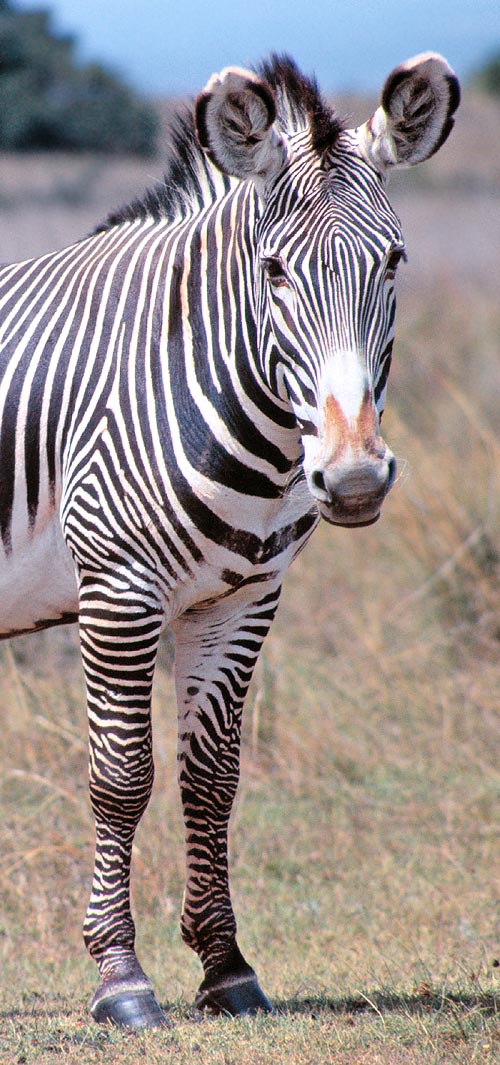
Solid structure and big hooves. Communicates also with eyes and ears © G. Mazza
The typical white and black striation which renders unmistakable a zebra, in general, even to the most uninitiated person in the zoological field, may however cause, in the ..amateur, some confusion between mountain zebra, Hartman’s zebra and Burchell’s zebra (please see relevant texts), animals differing for some particulars, which, however, do not catch our eyes like angry cats, as on the contrary happens for the livery of the Grévy’s zebra.
And indeed, the mantle of this species, typical of eastern Africa, is so particular, even in its likeness to the striped pyjama of its cousins, to generate in somebody that same odd feeling which assails us when we see two almost identical twins but which we can quite well distinguish for a certain particular which, offhand, we find hard to locate, but that makes the difference.
The black striae are much closer and thinner, present in greater quantity, at least apparently, more regular and form on the rump characteristic drawings called “bull’s eyes”, that is similar to the eye of an ox.
The black striae of the neck, very clear, prolong on the mane, thus making the neck to seem much more massive and muscular than what it is already.
But it is not the livery only to generate that neat and at times undefined impression of being in front of another animal, when we make a comparison with the other zebras, but also the “overall” look.
Whilst the “mountain” zebra and the various subspecies of the Burchell’s zebras do have, in the whole, the look of horses, or better, seen the size, of ponies, the Grévy’s one, even if being the greatest amongst the zebras, decidedly resembres to a big mule or an ass: the head is far more massive and the rounded ears are quite bigger and more evident, extremely mobile and often “expressive”, clear indicator of the “mood” of the animal (aggressivity, submission, attention, fear, etc.), furthermore, this species is the only one belonging to the subgenus Dolichohippus (dolichos in old Greek means long), whilst the other zebras belong to the subgenus Hippotigris.
But the zebra we are treating of is a continuous source of surprises and is an exception also when taxonomically talking.
We might expect that Mr. Grévy, of whom it is named after, was a valiant African explorer, a hunter, or a naturalist on the field, but this is not the case: in reality, Jules Grévy was President of the French Republic from 1879 to 1887, and the concerned zebra was described by a totally different person, a Mr. Emile Oustalet, a French zoologist who called it in this way in honour to his President.
The geographic distribution is rather limited, as it includes part of Kenya and Etyhiopia, and the ecological niche occupied by this herbivore is particular, halway between the water dependence typical of the other zebras (who, even if adapting to arid zones, need to drink on a daily frequency, also due to their diet based on often coriaceous grasses and to their non-ruminant digestive system and therefore less performant) and that much less water dependent of the wild African ass, a purely “deserticolous” animal.
In any case, for what the digestive system is concerned, what has been said in the text of the Burchell’s zebra (Equus quagga burchelli does apply. The typical habitat is the woody savannah, with a predominant presence of acacias and other spiny plants of the group Commiphora, plants from whose resins are often obtained incenses and perfumed substances (typical the myrrh, extracted from the Commiphora myrrha).
Normally, the Grévy’s zebras are able to obtain the necessary liquids from the alimentation, and are more frugal in drinking, as they may content of a real water intake every 5 or 6 days, this especially during the rainy season, that is, for the zones where they live, from July to November, however, during the dry season or during drought periods, they can move to higher and wetter areas and are more dependent from the presence of water reserves.
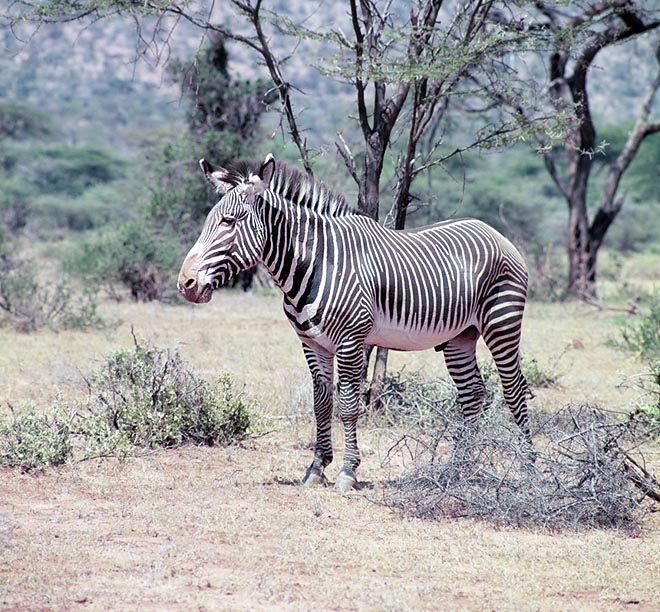
Equus grevyi typical habitat is the woody savannah. Bears drought better than other zebras © Giuseppe Mazza
The real harem, as for the other zebras, does not exist and the only “stable” group is the association female-last offspring (one or two foals), whilst the association of more family groups and of other heads forms herds at times even numerous but unstable.
Usually, a typical herd includes not more than a dozen of mares with offspring but, during the rainy season, more herds may join together (even if the term “herd” is not perhaps correct, seen the instability and the variability of such associations), to count up to 100 or 200 heads.
During the seasonal migrations towards more suitable for grazing areas, then, it is not rare to count also several hundreds of heads, up to 500 in such instances, but these groupings cannot be by sure considered as herds, even if we can observe sub-groupings by classes or by age or of other type, for instance, females with accompanying foals or young males.
The casuality and volatility of such groupings is shown also by another fact: in the places where the distribution range of the Equus grevyi and the northernmost Equus quagga boehmi overlap, it is not rare, during the migrations, to see the two species blithely mixed in a carefree promiscuity.
The Grévy’s zebra stallions clearly differ, as behaviour, from those of the other zebras: they are not masters of a harem and are, on the contrary, territorial: whilst a mature male of a Burchell’s zebra does not defend a territory but its own harem, a Grévy’s zebra stallion will furiously defend its territory which is, as an average, of 4-7 square kilometres, and this at least during the rain season.
Nevertheless, if there is sufficient water in the zone, some stallions keep and protect their own territory also during the dry season, also when the majority of the population is far away, on the highlands, which are richer of pasture.
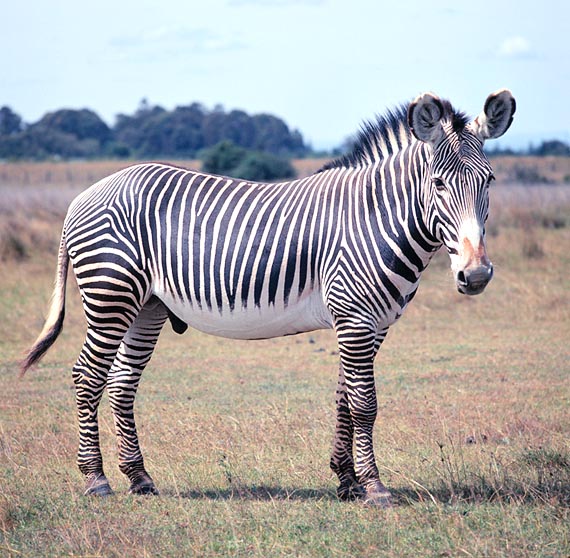
Stallion has no harem, territorial and little romantic. Shameless female © Giuseppe Mazza
The aggressiveness of the males towards younger males who penetrate their territory will be surprisingly low, but when females are present the things change and the tolerance disappears.
The male can reproduce by around the 6 or 7 years of age, whilst the female is more precocious and can generate when three years old.
The oestrum lasts about one week (from 4 to 10 days) and the gestation lasts almost one year, after which the female may enter again into oestrum just a few days after the delivery.
A female in oestrum is easily recognizable, not only for some signs of receptivity, such as turgidity of the sexual organ, mucosal losses and frequency of urination, but also, and mainly, due to a remarkable …impudence and lack of inhibition in inviting the stallion: the typical position is with stretched out legs, with the hind ones wide apart, tail raised and mouth often open and, if the male is close, often the female gets close to him “in reverse gear”, as if to force him, if ever there should be a need for this.
For its part, the stallion of the Grévy’s zebra seems to be the opposite of the shy and romantic suitor and at times tends to be rather violent in its manifestations, as it happens for the asses, with bites and pursuits more similar to the rape than to the courting, even if there are gestures more …tender, if we wish to utilize a maybe too humanized wording, such as the leaning the head on the back of the female.
The Grévy’s zebra, like all zebras and the equids, is a perossodactyl (uneven toes), which lays the weight of the body on only one toe per leg, obviously a very robust toe, and equipped with a highly specialized nail, the hoof.
The gait, or, better, the gaits, is the typical ones of all equids: walk, trot and gallop are almost the same as of the horse and since the trot, in particular, results looser and more spontaneous than in the bigger species (also between the domestic horses), the Grévy’s zebra appears to adopt this gait more naturally and more frequently than the other species of zebras.
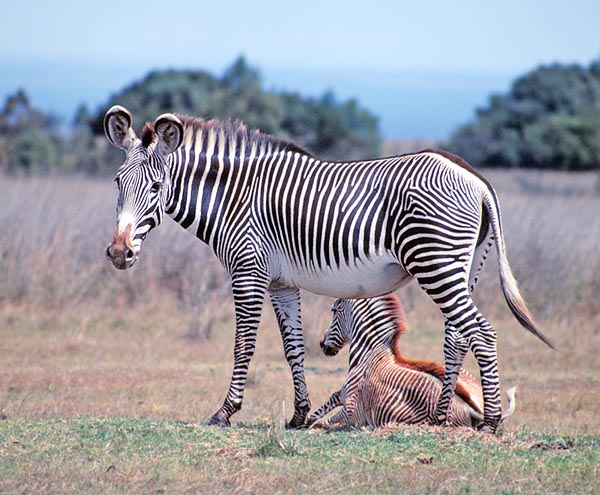
Mother with foal. Pregnancy lasts almost a year © Giuseppe Mazza
In the moments of rest, of siesta in the shade and of sleep, the equids take a position quite different from that of the ruminants, as their keeled rib cage does not allow them to lie down on the sternum with the limbs folded under the body, and so, after “kneeling” on the four limbs, they lie on the side.
Furthermore, they love to often “wallow”, for taking their bathe in the dust or for getting rid of the parasites, as they are able to effect a complete turn, moving the legs from the right side to the left one by rotating the body, thing that, usually, the ruminants (and also the mountain zebra, exception among the equids), do not do.
The communication between different individuals occurs with various modalities.
The sound communication is of great importance, as for all equids, with a fairly various repertoire of sounds, it is however necessary to say that, whilst many vocalizations are similar for the various species, those of true and proper communication among individuals varies depending on the species.
A sound of satisfaction, often audible at the pasture, is obtained by blowing air from the lungs and keeping “morbid” the upper lip, in such a way to have it vibrating in a sonorous “Prrrrrrr”, then there are also a pair of alarm sounds, consisting in a short asinine i-haa, but much softer, almost soft, or in a sonorous whiff, whilst surprise and pain (for instance for a bite or a kick gotten) are manifested with a sort of a bleating and deep cry: all these sounds are common in the various equids.
On the contrary, the vocalizations for calling and for keeping contacts fairly differ among the species: the neigh is typical of the horses, whilst the Burchell’s zebra emits a sort of barking sound and the Grévy’s zebra utilizes a bray similar to that of a donkey.
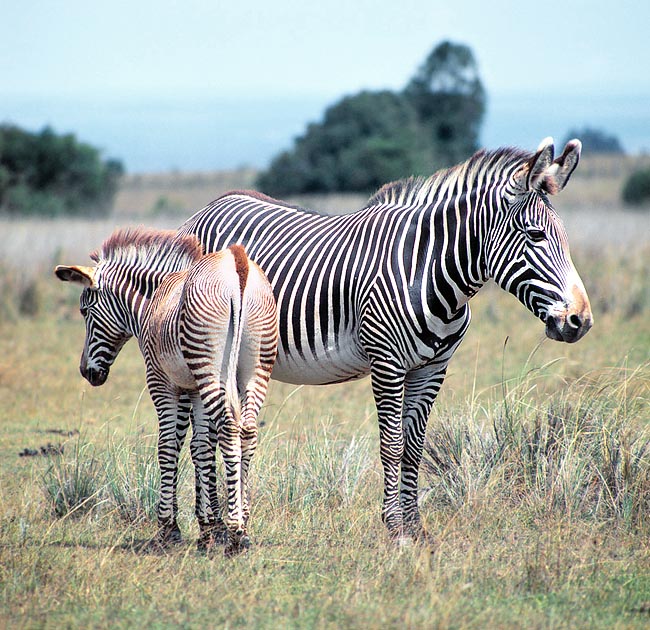
Males reproduce when 6-7 years old. Females, more precocious, when 3 © Giuseppe Mazza
The body language, for instance, is extremely expressive and various: unlike other herbivores, the facial mimicry is sophisticated, thanks also to the mobility of the upper lip.
Apart the “grimace” of the flehmen, with the raising and curling of the upper lip (common to many herbivorous as well as carnivorous species), which allows to draw odorous or liquid particles present in the urine of the female and establish if it is receptive, conveying them to the vomeronasal organ, the exhibiting the teeth plays an important role in the communication of the own “mood”, also because the robust teeth, even if it is herbivorous, represent a weapon not to be underestimated.
The position of the big ears and the facial mimicry may express a vast range of moods, as well as the posture and the movements of the head, the tail and the limbs. One of the most common menacing forms consists in the flattening of the ears accompanied by a waving of the tail, while the head is lowered and “wobbled” to the right and the left. An attempt to impose its own dominance shows with an erect posture, rigid legs and the head kept high, while the animal shows the side in order to expose the competitor the maximum of its mass, but this is a common characteristic to many species and by sure not limited only to the zebra.
In addition to this, like the horse, certain movements express quite clearly the menace of a kick with the forelegs or a dangerous “double” with the hind legs and also the exhibiting the teeth, as we have seen, gesture often accompanied by an eloquent aggressive movement forward of the head, is a prelude to a bite which can prove devastating, seen the strength of the masticatory muscles.
Therefore, concluding, we may say that the Grévy’s zebra is an equid with its own well-marked “personality” that clearly distinguishes it from the other African cousins, and being a rather irritable and aristocratic animal, it would offend a lot to be mistaken with some more or less distant relative: in short, it’s easy to say zebra, but Grévy’s is another matter!
→ For general information about PERISSODACTYLA please click here.
